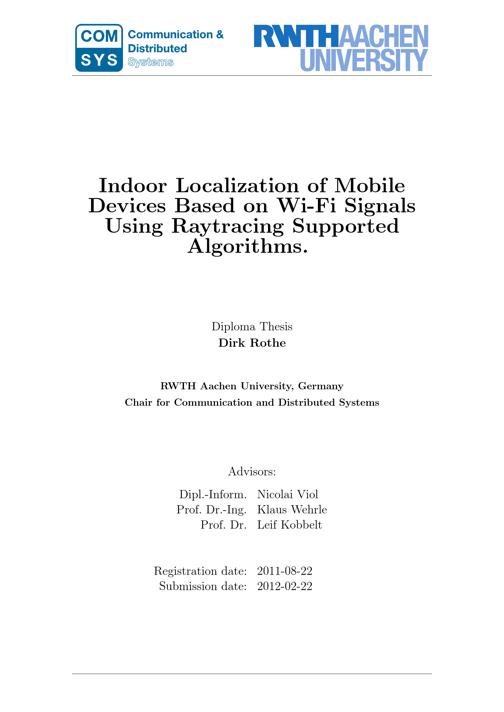forms/A_titleinfo/info
Sie können dieses Dokument editieren.
Titelaufnahme
Titelaufnahme
- TitelIndoor Localization of Mobile Devices Based on Wi-Fi Signals Using Raytracing Supported Algorithms
- Verfasser
- Erschienen
- UmfangOnline-Ressource (122 S. = 8,97 mb)
- HochschulschriftAachen, RWTH, Dipl., 2012
- AnmerkungTag der Einreichung: 22.2.2012
- SpracheEnglisch
- DokumenttypDiplomarbeit
- Institution
- Betreuer
- Schlagwörter
- URN
Zugriffsbeschränkung
- Das Dokument ist frei verfügbar
Links
- Social MediaShare
- NachweisKein Nachweis verfügbar
- IIIF
Download
Klassifikation
Abstract
This thesis focuses on the localization problem adapted to the constraints of a raytracer simulated signal distribution for Wi-Fi capable mobile devices in indoor scenarios. The localization problem is defined as predicting the most probable locations for an observed sequence of Wi-Fi signal strength readings. An accurately performing solution is of high interest because Wi-Fi signals can be observed cheaply due to an already widespread deployment of Access Points. For an efficient analysis of the problem, a framework is implemented that combines the raytracing, the localization and evaluation components. Based on this framework, it is investigated whether the raytracing tool provides an effective basis for an accurate Wi-Fi localization system. Furthermore, the performance of a Hidden Markov Model, a Particle Filter and a Nearest Neighbour based localization approach are evaluated on automatically trained raytracer models. Therefore, a representative corpus of location annotated signal measurements is assembled and subsequently employed for a thorough investigation of the algorithm properties with respect to tracking the device in scenes of various complexity. The trained Wi-Fi signal strength predictions diverge in average by 4dBm from the real measurements. Under these predictions, the tracking algorithms reach a localization accuracy of about 1.5m on pathways and degrades up to 4m in complex scenes like stairways.
Zusammenfassung
- Video
Titel: Top 500 localization hypothesis for a straight walk from the left side to right side of the building. The white points are the distributed Access Points. Duration: 28 Sec Resolution: 1920x1080 Format: H264/AAC Size: 2.5 MB
Inhalt
Statistik
- Das PDF-Dokument wurde 116 mal heruntergeladen.
Lizenz-/Rechtehinweis

